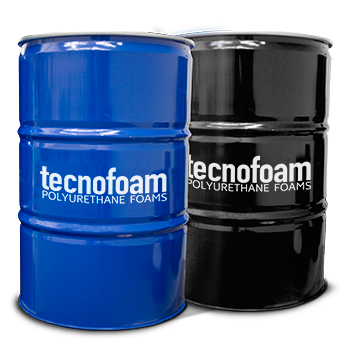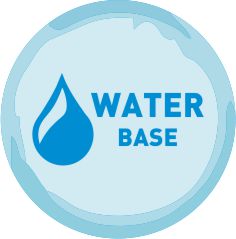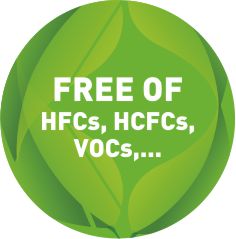TECNOFOAM G-2008

Spray polyurethane foam (SPF) system for thermal insulation (applied density ±8 kg/m³)
TECNOFOAM G-2008 thermal insulation open cell polyurethane system TECNOFOAM G-2008 is specifically formulated to apply low density foam (±8~10 kg/m³). Its application has to be done by the specific spray equipment. The blowing agent is water




Use
The polyurethane foam system TECNOFOAM G-2008 can be used in these situations:
- application continuous thermal insulation systems in residential buildings, businesses or industries
- indoor applications ceilings, interior chambers facade, ventilated facades, internal side of roofs, made with wood structure, or other material (see compatibility)
NOTE: For other applications / situations, please, consult our technical department
| applied density | ± 8~10 kg/m³ |
| reaction to fire | Euroclass E |
| thermal conductivity | 0,038 ± 0,001W/m·K |
| emissions(VOC) | A+aC |
| application | spray equipment |
GENERAL FEATURES
- TECNOFOAM G-2008 is a product with high thermal insulating capacity, easy to apply and to protect all the internal surfaces of the building
- the application and training is done by our spray equipment TC2049 or similar
- the blowing agent is water
- it is free from harmful to the ozone layer, so do not promote the greenhouse effect (NOT contain HFCs, HCFCs, VOCs, etc ...).
- TECNOFOAM G-2008 system is 100% recyclable by mechanical means friendly to the environment
- no gas collection for recycling and / or destruction is required
- the heat transfer coefficient is unchanged from λ placement and along the product life unlike the foam produced from gas low boiling.
- it does not emit any substance to the environment once installed.
- the properties of the polyurethane foam system TECNOFOAM G-2008 allow it to adhere to any surface such as concrete, ceramic, metal, polyurethane foam, wood, acrylic paints (checking the situation of areas recommended).
- TECNOFOAM G-2008 is a continuous thermal insulation system, instead of classic non-continuous thermal materials. It saves any kind of union between applications, providing a surface with optimum thermal insulation parameters
- it has CE mark on the basis of a declaration of performance DoP prepared in accordance with EU regulation 305/2011 statement available on demand.
YIELD
The performance is around 1kg/m², thickness of 10 cms.
PACKAGING
Metal drums of 220 kg for the polyol, and 250 kg for the isocyanate.
SHELF LIFE
POLYOL COMPOUND: 3 months / 6 months (need to be shaken before use)
ISOCYANATE COMPOUND: 12 months
Temperature within 5 ºC ~ 35 ºC, provided it is stored in a dry place, non direct contact with sun.
APPLICATION METHOD
In general, you should take the following factors:
- the application of polyurethane foam system TECNOFOAM G-2008, should be performed under non-presence of moisture or water from the support stand on which to apply either at the time of application as a posteriori.
- the substrate must be clean and free of dust
- in applications with high temperature gradients a vapor barrier is placed on the warm side of the insulation to prevent condensation
- metal surfaces should be protected with an anti corrosive primer before being coated with foam. On smooth surfaces without pores, galvanized steel, polypropylene, etc ... a secure grip primer should be applied
- applied in one direction to achieve the expansion which is about 10 ~ 12 cm.
- if necessary, and once fully expanded, apply a second layer on the already initially applied.
- its great expansion causes sometimes have to cut the excess with the help of a saw
- TECNOFOAM G-2008 adheres firmly on most common materials such as wood, plasterboard, steel, OSB, plywood, cement, inside masonry exterior plaster panels, and construction itself.
- reactivity times (in laboratory conditions):
- REACTING TIME: 4-8 seconds
- EXPANDING TIME: 11-15 seconds
APPLICATION REQUIREMENTS (spray equipment)
For the formation, it is necessary to mix the two initial liquid components, isocyanates and amines by our our spray equipment TC2049 or similar (proper maintenance and cleaning it is recommended). The general parameters for this material, will be the following:
- Heater isocyanate temperature: ±40-45 ºC
- Heater amines temperature:±45-55ºC
- Hose temperature:±45-50ºC
- Pressure:1.700-2.000 psi
These temperature and pressure parameters have to be valued, ratified or be varied by the applicator, depending on the conditions of each climate zone, weather situation or as projection equipment specifications.
HANDLING
These safety recommendations for handling, are necessary for the implementation process as well as in the pre-and post, on exposure to the loading machinery.
- Respiratory Protection: When handling or spraying use an air-purifying respirator.
- Skin protection: Use rubber gloves, remove immediately after contamination. Wear clean body-covering. Wash thoroughly with soap and water after work and before eating, drinking or smoking.
- Eye / Face: Wear safety goggles to prevent splashing and exposure to particles in air.
- Waste: Waste generation should be avoided or minimized.
- Incinerate under controlled conditions in accordance with local laws and national regulations.
Anyway, consult the safety data sheet of the product, are publicly available.
TECHNICAL DATA (according Declaration of Performance)
Essential characteristics |
Performance |
Harmonized technical specification |
Fire reaction |
Euroclass F¹ |
EN 13501-1:2007 |
Water absorption (short term by partial immersion) |
Wp ≤ 13,8 kg/m² |
|
Thermal resistance (conductivity λ90/90) |
0,036W/(m.K)initial 0,038 W/(m.K)aged |
EN 12667:2002 |
Water vapor permeability |
Water vapor resistance factor: µ=4,6 |
EN 12086 |
Compressive strength |
No performance declared (NPD) |
EN 826 |
Durability of reaction to fire against |
Values after aging |
EN 14315·1:2013 |
Verification of the composite emissions’ absence CMR 1 o 2 |
Satisfaction a § 4.3.7 of the norm > YES |
NF EN ISO 16000-3/-6/-9/-11 |
Regulatory labeling |
Emission class: A |
NF EN ISO 16000-3/-6/-9/-11 |
¹ B-s1,d0, with plasterboard |
||
To obtain more information, consult the full document Declaration of Performances of particular system (consult our technical department).
VOC Expositions table:
Component |
N° CAS |
C exp at 28 days |
Class |
formaldehyde |
50-00-0 |
8 |
A+ |
acetaldehyde |
75-07-0 |
5 |
A+ |
toluene |
108-88-3 |
1 |
A+ |
tetrachloroethylene |
127-18-4 |
|
A+ |
xylene |
108-38-3 |
<1 |
A+ |
1,2,4-trimethylbenzene |
95-63-6 |
0 |
A+ |
1,4-dichlorobenzene |
106-46-7 |
|
A+ |
ethyl benzene |
100-41-4 |
|
A+ |
2-butoxyethanol |
111-76-2 |
|
A+ |
Styrene |
100-42-5 |
1 |
A+ |
TCOV |
--- |
1011 |
A |
Resulting emission class |
A |
||

 About
About
 Products
Products
 Systems
Systems
 Price list
Price list
 Services
Services
 Construction projects
Construction projects
 Contacts
Contacts
 Call us
Call us